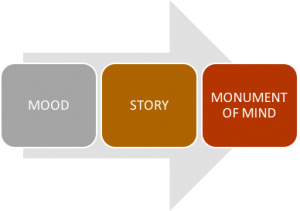Seeking Sanity During National Eating Disorders Week
 Would you rather be sane and satiated or dieting and deprived? The answer seems obvious, but we live in an age of extreme diets and fake foods. We watch television shows called The Biggest Loser and Extreme Makeover Weight Loss—along with commercials for gooey pizza, hot cheese stretched lavishly to the limits of our food cue endurance. And then there are the video “testimonials” for exercise programs where spokesmodels rave, “I went from a size 8 to a size 2!” Note to all you sadists-aka-advertisers: I wasn’t born a size 2. If I was, I exceeded it by age 5. I’m not sure how many people find your commercials motivating; I doubt it’s the average American woman, who is closer to a size 16.
Would you rather be sane and satiated or dieting and deprived? The answer seems obvious, but we live in an age of extreme diets and fake foods. We watch television shows called The Biggest Loser and Extreme Makeover Weight Loss—along with commercials for gooey pizza, hot cheese stretched lavishly to the limits of our food cue endurance. And then there are the video “testimonials” for exercise programs where spokesmodels rave, “I went from a size 8 to a size 2!” Note to all you sadists-aka-advertisers: I wasn’t born a size 2. If I was, I exceeded it by age 5. I’m not sure how many people find your commercials motivating; I doubt it’s the average American woman, who is closer to a size 16.
Given that maybe 5% of women look like fashion models naturally (never mind surgical enhancements), is it any wonder the other 95% of us feel anxious and discouraged?
“Anxiety” Drives Eating Disorders
During National Eating Disorders Awareness Week, marches are being held around the nation to support the 30 million Americans and their families who are impacted by eating disorders. Anxiety and eating disorders have genetic components—that’s true—as does one’s predisposition to be a certain size. But as I said to the mother of a teenager recently, who wouldn’t have anxiety given the hyper-focus on body image circulating in our hyper-media? We’re living in a world where Lady Gaga is body-shamed after her Super Bowl performance for having a “belly roll.” As if those who carp from cyberspace could actually sing and dance and be that persona—pfft!!! We’re living in a world that extolls being a size 2 when most of us are closer to size 16. We need to fight these toxic messages like Lady Gaga did; we need to trounce trolls, bust bullies, and seek sanity and sustenance.
Tragically, a recent study found that 80% of ten-year-old American girls have already been on a diet. Boys weren’t spared: fully one-third of boys and the majority of girls, aged six to eight, wished they were thinner. It’s a safe bet that these children’s parents are concerned about weight and body image, too, since two out of three American adults are now overweight or obese. The problem is that dieting leads to deprivation, and deprivation leads to binge eating. This über-important but under-acknowledged fact needs much more recognition.
Do Diets Cause Eating Disorders?
Diet-induced binge eating was documented during World War II in the “Minnesota Starvation Experiment.” (You read that right—over 70 years ago.) In 1944, 36 men in their twenties resided at the University of Minnesota as volunteers for an experiment on the psychological and physiological effects of starvation. The study was conceived “amid the privations of World War II” to help researchers and relief workers learn how to help people recover from starvation. The men ate normally for 12 weeks to establish baseline functions, and then “starved” for 24 weeks, eating about 1,500 calories a day (less than half their normal daily caloric intakes). They were then rehabilitated for 12 weeks.
During the semi-starvation phase, all the men became obsessed with food. They fantasized about food, read and talked about food, and relished the two meals a day they were given. During this phase, one man went rogue and ate ice cream on an excursion into town. Hunger unleashed, he proceeded to devour a banana split, etc., etc.—he had a full-on binge. From that point forward all study participants had to have a buddy when they went off campus to prevent them from binge eating. NONE of these men had a history of eating disorders; ALL of them were screened in advance.
The Minnesota men developed eating patterns that sound curiously like Binge Eating Disorder (BED). The most common eating disorder, BED finally gained recognition by the American Psychological Association in 2013. Characterized by recurrent binge eating, coupled with a sense of loss of control and shame, BED differs from Bulimia Nervosa in that sufferers don’t purge or exercise excessively to offset unwanted calories. Consequently most people with BED gain weight, which adds to their woes. Weight stigma, feelings of shame, and lack of knowledge among medical providers compound the obstacles to those seeking help for BED.
After the experiment, volunteers reported issues with overeating and binge eating. One man found the biggest effects post-experiment were psychological; for years, even after he was able to eat normally, he would take candy bars with him everywhere. He was unable to stop thinking about food—and he was unable to stop worrying about being without food. When he started the experiment he weighed 175 pounds. During the experiment he lost 50 pounds, but after the experiment he gained 100 pounds, reaching a weight of 225 pounds. His obsession with food, the result of diet-induced scarcity, created a weight problem where none had existed!
It took three years for the 225 lbs. man’s weight to stabilize back to his normal weight, around 175 lbs. It’s worth noting that studies indicate it takes about a year for your body to find its set point after you experience a significant weight loss. During that year, assuming you’re eating healthfully and exercising moderately, you tend to stabilize around your natural set point. But where is your set point?
I’m a rescue-dog fanatic; here’s where I bring out my colorful breeds’ book and point out that some us are Golden Retrievers and some of us are Whippets. No matter how hard we diet, those of us who are Goldens will never be Whippets. That said, if our parents and siblings are normal weight–or they were before poor lifestyle habits caught up with them–our bodies will mimic theirs. This means children of Samoan descent usually weigh more than Filipino children. Wide variations exist between African-Americans, Hispanics and Caucasians—and wide variations exist within ethnicities too. When we crazy humans try to outfox genetics, we end up in the doghouse. Depriving ourselves of healthy nourishment – especially while we’re growing – ignites a losing battle between our bodies and our selves.
Shamed For Our Hunger
John Bradshaw, bestselling author of Healing the Shame that Binds You, says, “To be shame-bound means that whenever you feel any feeling, need or drive, you immediately feel ashamed. The dynamic core of your human life is grounded in your feelings, needs and drives. When these are bound by shame, you are shamed to the core.”
What happens when we feel shamed for our hunger and guilty when we eat? The pursuit of (impossible) perfection afflicts millions of girls and women; it damages our bodies and sears our psyches. Increasingly, boys and men are feeling the pressure too. “The media has become more and more of an equal opportunity discriminator. Men’s bodies are not good enough anymore either,” says Dr. Raymond Lemberg, an Arizona-based clinical psychologist and an expert on male eating disorders.
Despite a multi-million-dollar weight loss industry, bloated with fad diets and false promises, many dieters regain lost weight, and often they gain back more. The Biggest Loser proved drastic diets yield ephemeral results. For obvious reasons, no one can maintain such an extreme regimen—who even wants that lifestyle? Yet we continue to scold people for failing… without giving them a path out of the forest.
In a scathing rebuke to the diet-industrial-complex, Yoni Freedhoff, MD, puts it this way: “I don’t think 95% of people fail diets. I believe that 95% of diets fail people.” Offering hope to the 95% of us who are Goldens, he says, “Rather than criticize the players for failing to score, what we really need to do is fire the coaches, move the goalposts and stop with the nonsensical beliefs.” When people think they must suffer indefinitely (by being “good” on their diet) they aren’t motivated over the long term. Freedhoff asserts that it isn’t necessary or even reasonable for people to lose “every last pound” to become healthier. In fact, studies show that moderate weight loss yields positive results in terms of health markers.
Binge Eating Disorder and Weight Loss
Having worked in IOP (intensive outpatient) and PHP (partial hospitalization) eating disorders programs, I question the notion that “all foods are safe.” This notion may help anorectics, but for people struggling with BED or food addiction, it’s counterintuitive. For many of us certain foods can trigger binge eating.
In The End of Overeating: Taking Control of the Insatiable American Appetite, Dr. David Kessler, who busted Big Tobacco, believes our brain chemistry can be hijacked by foods that contain stimulating combinations of fat, sugar and salt. The truth is some of us are seduced by hyperpalatable foods and life will be easier—we’ll be healthier—if we limit our exposure to them. As Clint Eastwood said in 1973’s Magnum Force, “A man’s got to know his limitations.”
Recovery is labout eating wholesome foods we enjoy versus being “on a diet.” It’s about having reasonable expectations about weight and size. And finally it’s about hope. “Many people with BED have been put through the wringer of humiliation both as children and adults,” says Dr. Cynthia Bulik, Distinguished Professor of Eating Disorders in the Department of Psychiatry in the School of Medicine at the University of North Carolina at Chapel Hill. The good news is that BED is a very treatable disorder. “Those who want help should seek providers with experience treating eating disorders, especially BED,” she says.
During National Eating Disorders Awareness Week, hope is the torch we carry, for sanity and satiation, blazing like an Olympic flame. Let’s let Lady Gaga have the last word: “Be you, and be relentlessly you. That’s the stuff of champions.”
Tags: anxiety, binge eating, binge eating disorder, child development, critical self-image, eating disorders, negative body image, overeating, self-esteem, self-image








Leave a Reply